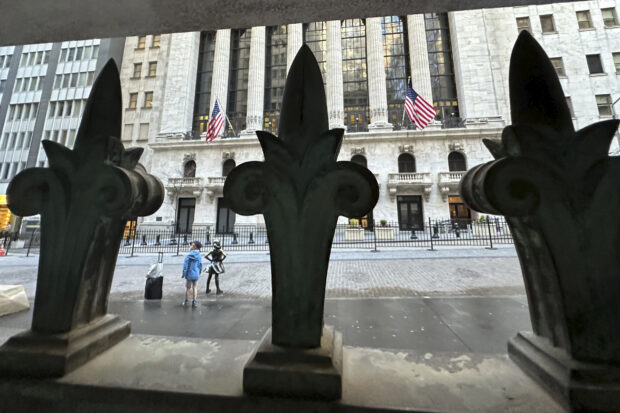
The New York Stock Exchange is seen, through a window guard, on Tuesday, April 16, 2024 in New York. Wall Street drifted toward gains as more corporate earnings came in, giving investors a break from fretting about if and when the Federal Reserve might cut interest rates. (AP Photo/Peter Morgan)
U.S. stock indexes drifted to a mixed finish on Thursday in a quiet day of trading.
The S&P 500 fell 11.09 points, or 0.2 percent, to 5,011.12 after flipping between small gains and losses throughout the day. The drop was slight, but it was still enough to send the index to a fifth straight loss. That’s its longest losing streak since October, and it’s sitting 4.6 percent below its record set late last month.
The Dow Jones Industrial Average edged up by 22.07 points, or 0.1 percent, to 37,775.38, and the Nasdaq composite slipped 81.87, or 0.5 percent, to 15,601.50.
Equifax dropped 8.5 percent for one of the market’s bigger losses after it reported weaker revenue for the latest quarter than analysts expected. High interest rates are pressuring its mortgage credit inquiry business.
The only stock to fall more in the S&P 500 was Las Vegas Sands, which sank 8.7 percent even though it reported better results than expected. Analysts said investors may be worried about the competition the casino and resort company is facing in Macau.
READ: When will the US Fed cut rates? Maybe later or not at all
Helping to offset those losses was Elevance Health, which climbed 3.2 percent after raising its profit forecast for the full year. Genuine Parts jumped 11.2 percent for the biggest gain in the S&P 500 after the distributor of automotive and industrial replacement parts reported stronger profit than analysts expected. It also raised its range for forecasted profit over the full year.
Stocks broadly have been struggling recently as yields in the bond market charge higher. They’re cranking up the pressure because investors have largely given up on hopes that the Federal Reserve will deliver many cuts to interest rates this year.
Yields climbed a bit higher after more reports on Thursday showed the U.S. economy remains stronger than expected.
Consumer demand
One report said fewer workers applied for unemployment benefits last week than economists expected. It’s the latest sign that the job market remains solid despite high interest rates.
That resilience “continues to generate a solid flow of paychecks to keep fueling consumer demand,” according to Carl Riccadonna, chief U.S. economist at BNP Paribas. His team is forecasting the U.S. economy grew at a faster rate in the first three months of the year than other economists generally.
READ: Retail sales surged 0.7% in March as Americans boosted spending
Another report on Thursday said growth in manufacturing in the mid-Atlantic region accelerated sharply when economists were expecting a contraction.
A third report said sales of previously occupied U.S. homes didn’t fall by quite as much last month as economists expected.
Similar data, along with a string of reports showing inflation has remained hotter than forecast this year, pushed top Fed officials to say recently they could hold interest rates high for a while.
It’s a letdown after the Fed earlier had signaled three cuts to interest rates could be possible this year. But Fed officials have been adamant they want to be sure inflation is heading down toward their 2 percent target before lowering the Fed’s main interest rate from its highest level since 2001.
Lower rates would juice the economy and financial markets, but they could also give inflation fuel to reaccelerate.
Interest rate cut expectations
Traders are now forecasting just one or two cuts to rates this year, according to data from CME Group, down from expectations for six or more at the start of the year.
In the bond market, the yield on the 10-year Treasury rose to 4.63 percent from 4.59 percent late Wednesday. The two-year Treasury yield, which moves more closely with expectations for Fed action, rose to 4.98 percent from 4.94 percent.
The hoped-for upside on Wall Street of a strong economy that’s keeping interest rates high is that it could also drive strong growth in profits. Companies will need to deliver such strength to justify the run stock prices have been on since late October, setting records along the way.
The recent drops in stock prices have made them look less expensive, but they won’t look cheap unless either prices fall further or profits jump higher.
Alaska Air, the carrier that suffered a midflight blowout of a door plug on a Boeing aircraft in January, rose 4 percent after it projected better profits for the current quarter than analysts expected.
Ally Financial jumped 6.7 percent after reporting stronger earnings for the latest quarter than Wall Street had forecast.
Ibotta, a Walmart-backed digital company that offers customers cash-back rewards and rebates on grocery brands ranging from Nestle to Coca-Cola, soared 17.3 percent in its first day of trading.
In stock markets abroad, indexes rose modestly across much of Europe and Asia. South Korea’s Kospi was a standout. It jumped 2% to help lead markets worldwide.